Lions are one of the world’s most feared and deadly predators, earning the moniker “king of the beasts”. Their commanding status of strength and ferocity comes from their many unique adaptations. Among these, the lion’s tongue stands out as a powerful but possibly lesser-known adaptation. The lion’s tongue is a fascinating aspect of feline anatomy with many remarkable characteristics. It plays a crucial role in various aspects of the animal’s life, from grooming and hygiene to assisting in their feeding habits. Here are some incredible features that distinguish a lion’s tongue.
Features of a Lion’s Tongue
1. Papillae and Spines
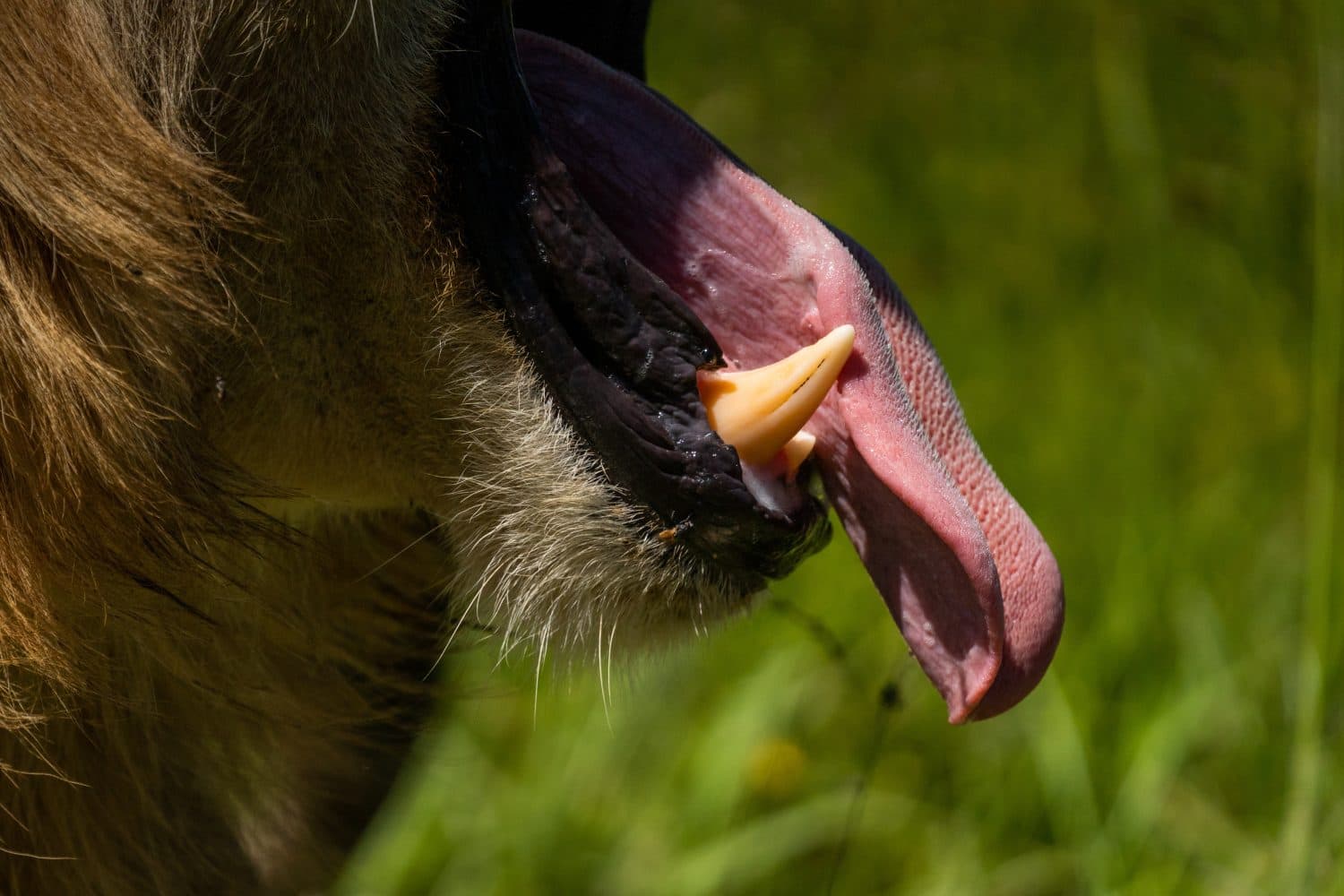
One of the most distinctive features of a lion’s tongue is the presence of numerous papillae.
©Chris Myhren/Shutterstock.com
Lions, like all cats, have numerous sharp and pointed hook-like structures called papillae on the surface of their tongue. These backward-facing, hook-like structures are covered in keratin, providing a rough texture to the tongue. This unique adaptation allows lions to efficiently strip meat from the bones of their prey. The papillae on a lion’s tongue are spaced and sized differently in various regions of the tongue. The front portion of the tongue typically has larger papillae, which may aid in gripping and tearing meat from prey. In contrast, the rear portion of the tongue has smaller papillae that are set closer together. This allows for more precise and efficient stripping of meat from bones. This adaptation showcases the evolutionary efficiency of the lion’s tongue for its predatory lifestyle.
2. Rough Precision
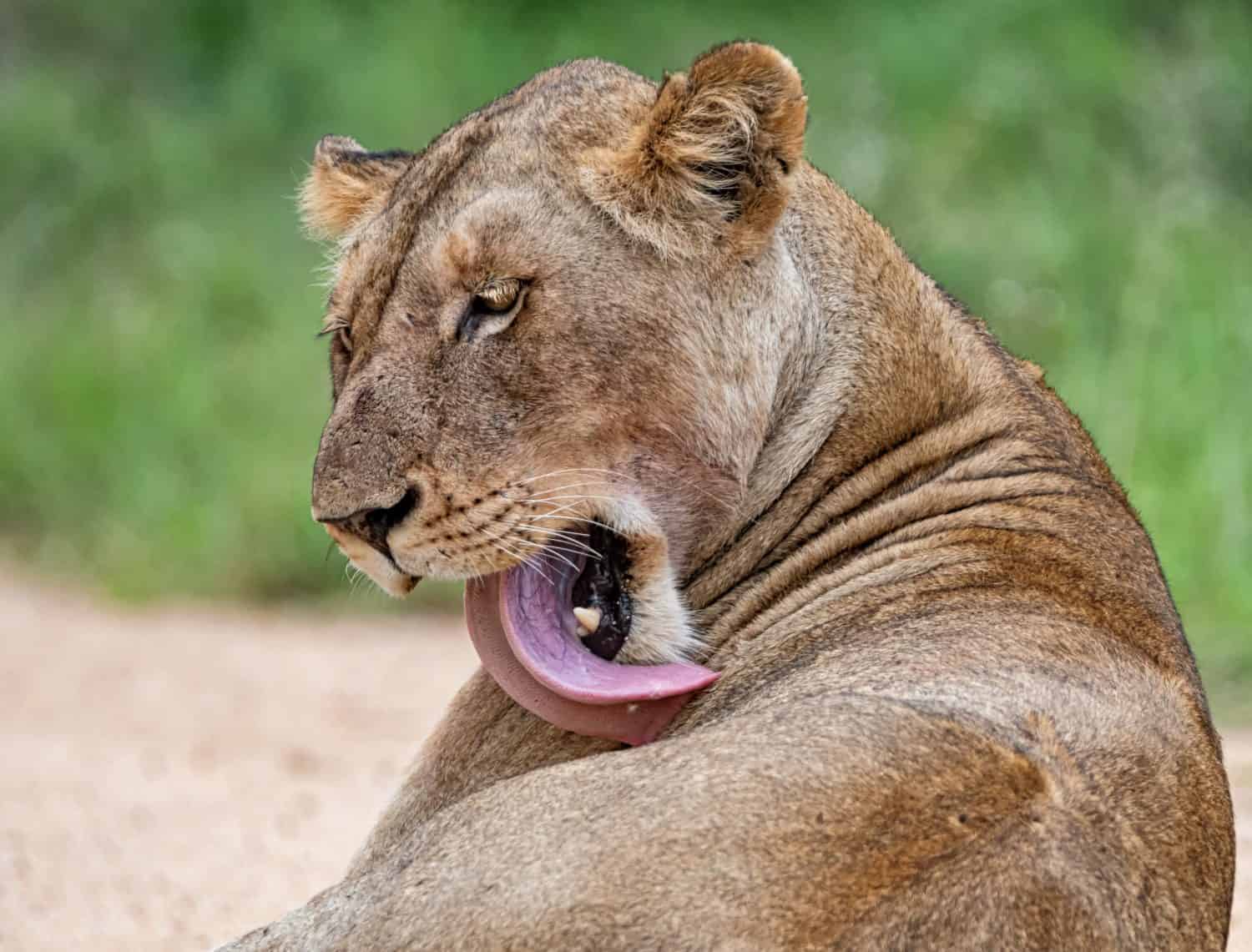
The papillae on a lion’s tongue work like an in-built comb allowing them to catch any debris or fur during grooming.
©Cathy Withers-Clarke/Shutterstock.com
Thanks to the many hook-like structures that cover the surface of a lion’s tongue, it possesses a texture akin to coarse sandpaper. The roughness of the lion’s tongue is so pronounced that with a little pressure, it can easily wound the human skin. However, this abrasive quality of a lion’s tongue serves a purpose beyond just aiding in meat removal from prey bones. It acts as a natural comb and plays an integral part in the lion’s grooming routine.
The lion’s fur, especially the shaggy mane of the majestic male is one of its most noticeable features. Maintaining the mane is no easy task though and requires meticulous grooming. As a study points out, the rear-facing spikes on a lion’s tongue are a unique mechanism to clean complex. hairy surfaces. With each lick, the spikes lift off any loose hair, dust, or debris entangled in the lion’s mane, contributing to its sleek and smooth appearance.
3. Feeding Efficiency
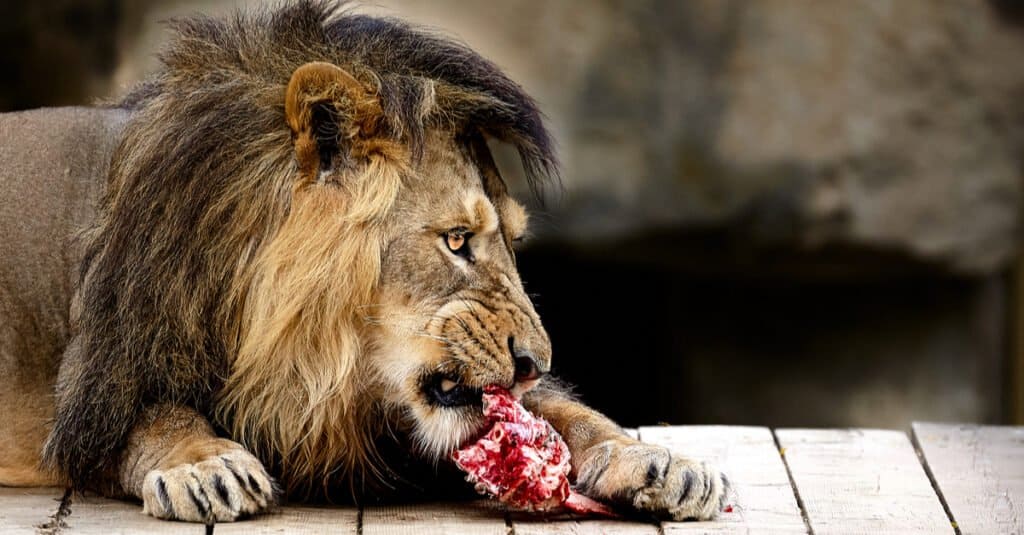
A fun fact about lions is that they are not great bone-eaters; the bones are usually left for the hyenas to break apart.
©J_K/Shutterstock.com
We’ve already mentioned the significance of the lion’s tongue as a crucial feeding tool. But we cannot underscore its role enough. The lion’s tongue doesn’t just serve as a mere instrument for devouring prey, it is an indispensable component in the choreography of the hunt. Lions lack the swiftness of many of their prey animals. With a top running speed of only 35 miles per hour, lions rely on a combination of patience, stealth, and an element of surprise during the hunt. It is in this dance of precision that the lion’s tongue, adorned with strategically placed papillae, takes center stage.
The spiky papillae contribute to an unparalleled level of precision, enabling the lion to tear and strip meat with finesse. Post capture, the lion also uses its tongue to lick its prey clean. Beyond cleaning the prey of its fur and feathers, the sharp, hooked spikes on the tongue play a dual role by tenderizing the flesh. Lions, of course, possess powerful jaws lined with teeth. But they reserve their teeth only for the vital tasks of holding on to and killing prey.
4. An Unconventional Water-Drinking Aid
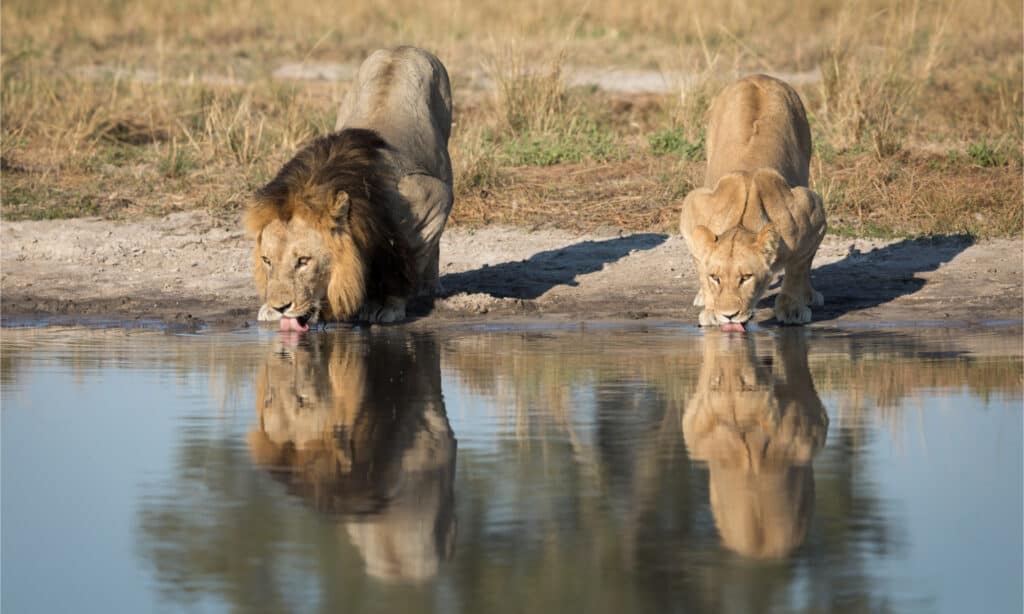
Lions do not require a lot of water as they usually get enough from the meat they eat.
©Stu Porter/Shutterstock.com
Another remarkable feature of the uniquely designed lion’s tongue with its backward-facing papillae is its distinctive role in helping the animal drink water. Unlike dogs, who use their tongue to scoop water into their mouths, lions employ a unique approach when drinking water- they use the tip of their tongue to draw water upward. The scratchy barbs on the tongue’s surface aid in pulling the water up.
As the lion laps up the water with the curled tip of its tongue, it will retract its tongue almost as quickly as it touches the surface of the water to prevent gravity from pulling the liquid column back towards the earth. The whole process happens at lightning speed, making it challenging for the human eye to catch in real time. But, this unique adaptation showcases the precision and efficiency of the lion’s tongue not only in hunting and grooming but also in the essential act of drinking water in their natural habitat.
5. Communication Center

When lions haven’t seen one another in a while, they are known to greet each other with enthusiastic licks to signal their friendly intentions.
©Howard Darby/Shutterstock.com
Lions rely extensively on licking as a means of communication within their pride. Unlike many other cat species, lions place a significant emphasis on family life. They reside in closely-knit units known as ‘the pride.’ The pride underscores the importance of social bonds in lion society and is usually made up of adult females, one or more adult males, and their cubs. Despite their strong familial ties, pride members often spend extended periods apart, engaging in various activities such as hunting, nursing cubs, or socializing within smaller groups of the same sex or age. Given their intermittent separation, effective communication becomes vital for conveying thoughts, intentions, and emotions. Licking is a notable behavior through which lions express friendliness and maintain social bonds.
Much like domestic cats, lions also engage in mutual licking and grooming, particularly among mothers and their cubs. This grooming ritual not only serves practical purposes, such as maintaining cleanliness but also reinforces the social cohesion within the pride.
6. Tasteful Tastebuds
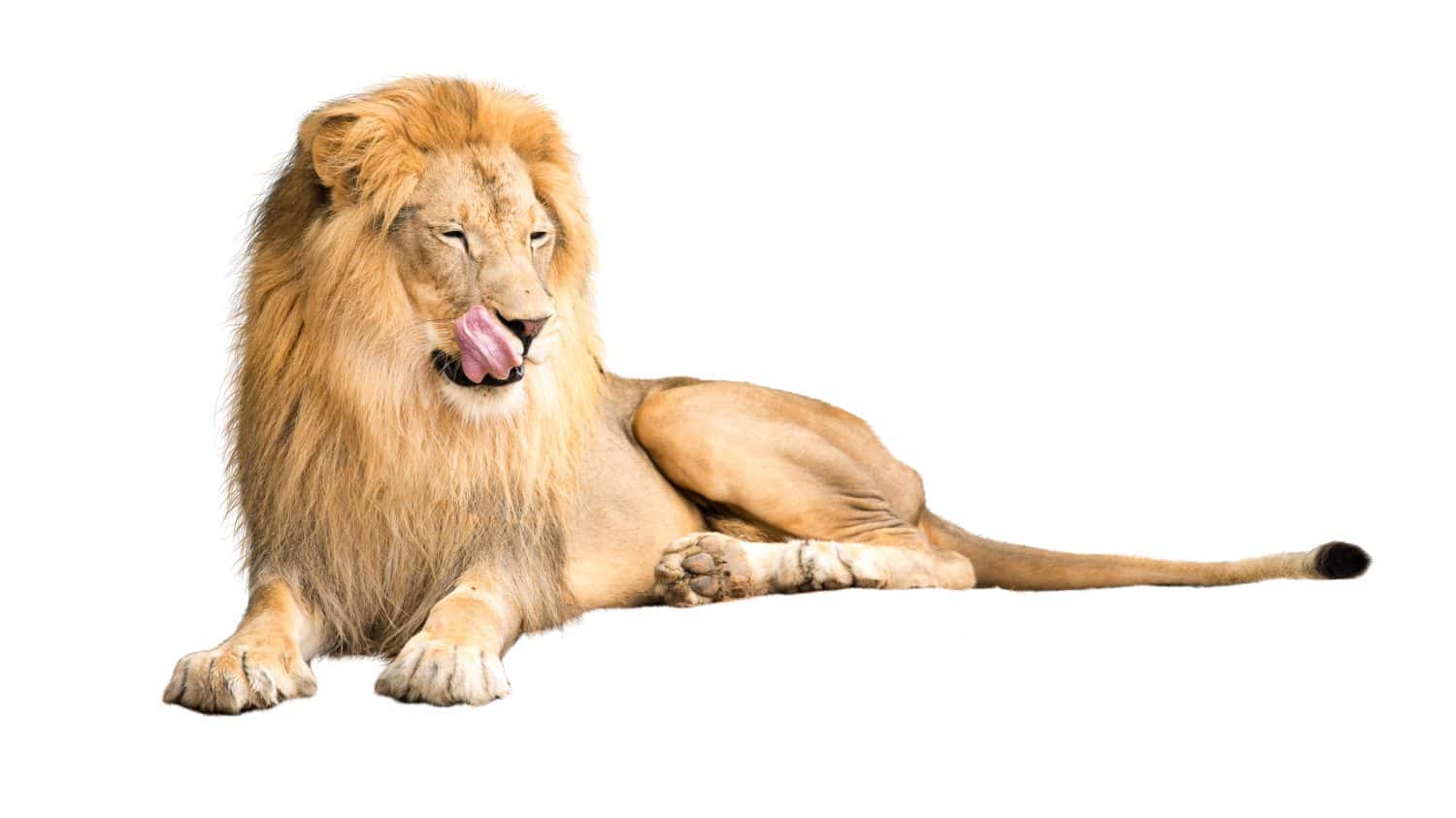
A lion’s sense of taste, although not as elaborate or nuanced as some other animals, is specialized to serve specific functions that are essential for their survival.
©GoodFocused/Shutterstock.com
Similar to humans, a lion’s tongue is equipped with taste buds. However, unlike human taste buds that enable the perception of five distinct tastes—sweet, salty, sour, bitter, and umami—lions are nearly taste-blind to sweetness. Lions possess only around 470 taste buds, a significant contrast to the eight to ten thousand taste buds found in humans. This limited number of taste buds means that lions experience a narrower range of flavors. They generally exhibit a heightened sensitivity to bitter flavors. This adaptation helps them as carnivores to avoid rancid meat.
7. Thermoregulation Tool

Licking their fur is one of the ways through which lions cool off in the hot summer.
©JMx Images/Shutterstock.com
Lions mainly live in Africa. Their habitats can range from the Skeleton Coast in Namibia to the Okavango Delta in Botswana, extending into East Africa and sometimes even reaching the forests of West Africa. Additionally, a limited population of lions is also found in India. Both India and Africa are two regions that continuously experience warm weather. Average temperatures rarely go below the range of 77-95 degrees Fahrenheit in the summer.
Given the warm climates in which lions reside, their thick mane becomes a challenge for thermoregulation. To cope with the heat, lions employ creative ways to stay cool. One such method involves licking their coats. As the lions lick themselves, the evaporating saliva from their thick manes releases heat from their bodies, providing a mechanism for thermoregulation and offering them a degree of comfort in warmer conditions.
Other Adaptive Features of a Lion
Eyes
Lions possess exceptional low-light vision, enhancing their hunting abilities during the night. In fact, the lion’s eyes are said to be almost six times more sensitive than those of humans. They are also experts at judging distances, which gives them a significant advantage when they are stalking, chasing, or pouncing on prey. A lion’s eyes are also especially attuned to spot things that are moving in their environment. When objects or creatures are standing still, they may not attract the attention of a lion as effectively as those in motion.
Hearing
While not much is known about the hearing abilities of lions, these creatures have been found to swiftly swivel at the slightest sounds. Their keen sense of hearing allows them to detect and locate sounds from any direction, giving them another significant advantage during hunting activities.
Mouth
Lions have very powerful jaws lined with thirty teeth. At the front, two pairs of long and sharply pointed canine teeth help the lion in holding onto and killing prey. Additionally, the narrow and sharp back teeth, known as carnassials, function like scissors, efficiently slicing through the flesh of their prey. This combination of teeth allows lions to effectively capture and consume their target during the hunting and feeding processes.
Paws
Lions have soft pads on the bottom of their paws that help cushion and muffle each step as they stealthily stalk their prey. Apart from this, their razor-sharp, curved claws also help them bring down prey and prevent it from escaping. The claws of a lion, like all cats are retractable, remaining pulled in when not in use and extending when needed for activities such as hunting or climbing.
Mane
Male lions are widely recognized for their distinctive manes, which serve multiple purposes. Beyond protecting them during fights, the mane is considered a symbol of health and virility. In the lion community, the attractiveness of a male to a lioness is often associated with the mane’s characteristics—generally, a fuller and darker mane is deemed more appealing.
Thank you for reading! Have some feedback for us? Contact the AZ Animals editorial team.







